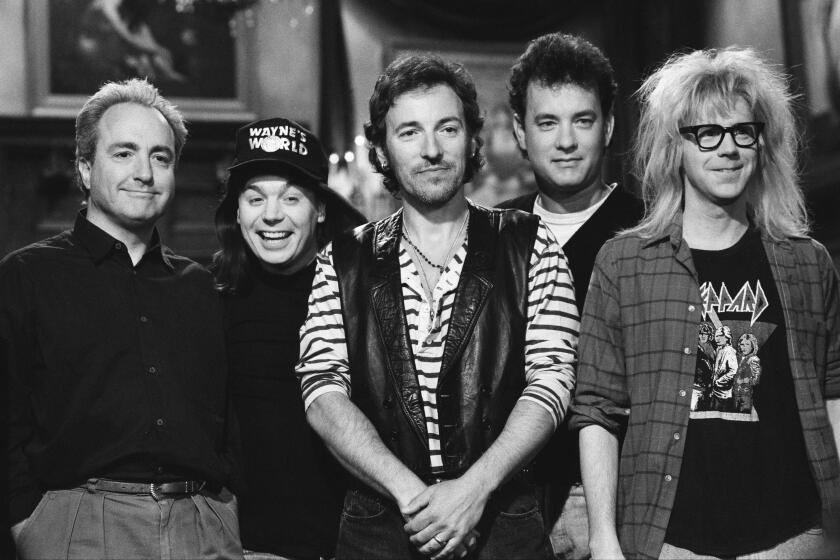Buried Music From Alta California
- Share via
Following the axiom that exotic treasures can be found buried in one’s own backyard, the Los Angeles-based vocal group calling itself Zephyr: Voices Unbound has embarked on a project that defines local color.
The focus is the music indigenous to California’s missions, the elaborate settlement system that represents a historical, social and aesthetic landmark in the state’s evolution, for better and worse, depending on one’s perspective. It was through the missions that European culture--including music--entered the Alta California landscape: Padres wrote liturgical music, and Native American choirs and musicians sang and played it.
Zephyr’s digging has resulted in the re-creation of a musical environment, a CD and a concert program that traces mission music’s influences from colonial Mexico City to Cahuilla Indian chant, and roughly reconstructs a day in the life of a mission, with Mass as the central element and side trips into nonliturgical songs as well.
The CD, “A Choir of Angels,” is newly released on the local label Civic Records, and three concerts based on it open the ensemble’s sixth performance season, including appearances in Encino on Saturday and in West Hollywood on Nov. 23.
Zephyr is by no means the first ensemble to revive mission music. Several years ago, choral composer-conductor John Biggs, now based in Ventura, put together a tape of musicological finds. In fact, it was Biggs’ arrangement of an anonymous “Padre Nuestro,” performed by Zephyr last season (and included on the new CD), that planted the seed for the current project. In the audience was Richard Lyons, head of Civic Records. He was impressed and proposed to the group an extensive gathering of mission music for a CD.
In researching the repertory, Paul Gibson, a charter member of Zephyr, consulted musicologists Craig Russell at Cal Poly in San Luis Obispo, William Summers at Dartmouth and Los Angeles-based music teacher and choir leader Robert Johnson. It was Summers who led Gibson to Missa de Los Angeles, a Mass that may have arrived in Alta California along with a Majorcan padre named Juan Batista Sancho, and it was Johnson who unearthed the “Magnificat” of Mexican composer Francisco Capillas, never before recorded. The Cahuilla chants--the tribe now has a reservation in Riverside County--are sung by tenor Kent Carlson, who learned them from Ernest Siva, a Cahuilla descendant and professor of ethnomusicology at UCLA.
From the outset, Zephyr wanted to broadly represent the sounds of the mission, says Gibson, to get at “the complex interrelationship between the padres, and the Indians, the vastly different cultures and the third culture that came from a meeting of the two.”
“There’s a lot of controversy and differing views as to what the whole thing was about, whether it was a good thing or a bad thing,” Gibson says. “Our goal wasn’t to take sides in a cultural war. It was to look back at how human beings expressed themselves in a spiritual context.”
At the missions, he says, “the center of life was the Mass, where they put all their musical resources.” Those resources, usually a choir of men and boys with some imported and some indigenous instruments, were hardly the stuff of European cathedrals.
“It was life in the desert,” Gibson says. “Not necessarily the perfect place to try to do [Beethoven’s] Missa Solemnis. But for that context, they were actually quite sophisticated.”
Even so, Zephyr decided to “spiff up” the music to some degree.
“Our main thrust was not necessarily to produce an authentic ‘reproduction,’ ” Gibson says, although period instruments, including Indian drums, bells from Mission San Juan Capistrano and period string players courtesy of L.A.-based Musica Angelica are all included on the recording.
Zephyr might not seem the likeliest candidate to undertake the task of resuscitating mission music. In its six-year history, the group has taken an eclectic and sometimes lighthearted approach to choral music. Its first foray into sacred music, last year, bore a typically glib concert title: “Make a Joyful Noise: Zephyr Gets Religion.”
“When I’m up there, I don’t want to bore people,” Gibson explains. “I want to engage them and have them leaving like they felt that they had something good happen.”
The group, founded by three singing friends, is a democratic organization with no music director. It performed its first concert on Halloween night 1992 with a program of early Greek music, contemporary classical music and Gilbert and Sullivan. Its seasons have steadily increased in size and scope, though most of its members still keep their day jobs.
Earlier this year, Zephyr toured with Anonymous Four, performing the Richard Einhorn oratorio “Voices of Light,” composed as an accompaniment for Carl Theodor Dreyer’s silent film classic “The Passion of Joan of Arc.” With the mission music CD, Zephyr’s recording career officially begins.
From Gibson’s standpoint, it’s a timely entry. Four of California’s 21 missions are celebrating their 200th anniversary in 1997, and Mission San Luis Rey, in Oceanside, turns 200 next year. For that occassion, Stephen Sturk, a musicologist at UC San Diego, is assembling a recording called “Mission Music of California: A Two Hundred Year Anthology.”
“Missions are in the air,” Gibson says. “It’s a coincidence that we’re joining in that effort, but I think there’s really something there to look at, in terms of music and also just the complex manifestation of humanity that occurred within the system.”*
* Zephyr: Voices Unbound, “Mission: California,” Saturday, 8 p.m., St. Nicholas Church, 17114 Ventura Blvd., Encino, and Nov. 23, 3 p.m., Metropolitan Community Church, 8714 Santa Monica Blvd., West Hollywood. $10-$15. (562) 927-7080.
More to Read
The biggest entertainment stories
Get our big stories about Hollywood, film, television, music, arts, culture and more right in your inbox as soon as they publish.
You may occasionally receive promotional content from the Los Angeles Times.










